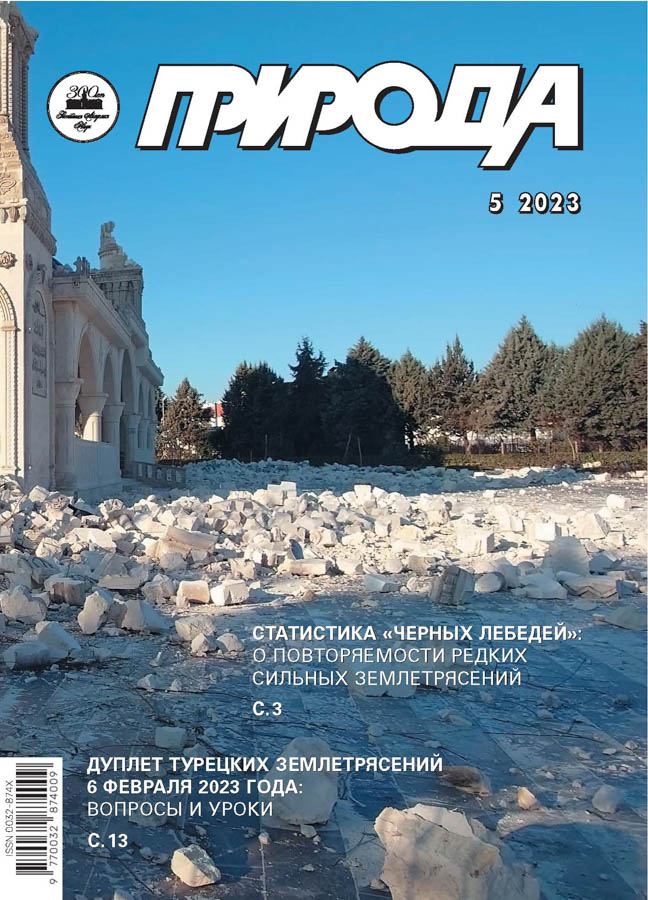“Black Swan” Statistics: on the Recurrence of Rare Strong Earthquakes
- 作者: Rodkin M.V1,2
-
隶属关系:
- Institute of Earthquake Prediction Theory and Mathematical Geophysics, Russian Academy of Sciences
- Institute of Marine Geology and Geophysics, Far Eastern Branch of the Russian Academy of Sciences
- 期: 编号 5 (2023)
- 页面: 3-12
- 栏目: Articles
- URL: https://journals.eco-vector.com/0032-874X/article/view/627797
- DOI: https://doi.org/10.7868/S0032874X23050010
- ID: 627797
如何引用文章
详细
Thanks to the American essayist Nassim Nicholas Taleb, the title “black swans” now describes unexpected, rare, and often destructive events and phenomena. The author attributed this beautiful image to extreme events that radically change the situation. It is often pointed out that the problem of “black swans” may be of key importance for the modern, extremely volatile, and potentially catastrophic world. “Black swans” appear suddenly, and it would be good to know at least some patterns of their appearance and frequency. It is known that the vast majority of various types of disasters, both of natural and man-made origin, is described by the power law of distribution, fi rst identifi ed for earthquakes (the Gutenberg—Richter earthquake recurrence law). More than that, the earthquake events are not only the very fi rst described by this law, but, perhaps, are the most famous, most provided with statistical data, and therefore the most studied. However, even for earthquakes, the nature of their statistics remains debatable. The article discusses the issues of the recurrence of strong earthquakes, the reduction of the caused losses, and earthquake insurance.
作者简介
M. Rodkin
Institute of Earthquake Prediction Theory and Mathematical Geophysics, Russian Academy of Sciences; Institute of Marine Geology and Geophysics, Far Eastern Branch of the Russian Academy of Sciences
Email: rodkin@mitp.ru
Moscow, Russia; Yuzhno-Sakhalinsk, Russia
参考
- Родкин М.В., Шебалин Н.В. Проблемы измерения катастроф. Известия РАН. Сер. Географическая. 1993; 5: 106–116.
- Писаренко В.Ф., Родкин М.В. Распределения с тяжелыми хвостами: приложения к анализу катастроф. Вычислительная сейсмология. Вып.38. М., 2007.
- Pisarenko V., Rodkin M. Distributions of characteristics of natural disasters: data and classification. Heavy-Tailed Distributions in Disaster Analysis. Advances in Natural and Technological Hazards Research. V.30. Dordrecht, 2010. doi: 10.1007/978-90-481-9171-0_1.
- Pisarenko V., Rodkin M. Statistical Analysis of Natural Disasters and Related Losses. Springer Briefs in Earth Sciences. Dordrecht—Heidelberg—London—New York, 2014.
- Pisarenko V.F., Rodkin M.V. Approaches to Solving the Maximum Possible Earthquake magnitude (Mmax) Problem. Surv. Geophys. 2022; 43: 561–595. doi: 10.1007/s10712-021-09673-1.
- Rong Y., Jackson D.D., Magistrale H., Goldfinger C. Magnitude limits of subduction zone earthquakes. Bulletin of the Seismological Society of America. 2014; 104(5). doi: 10.1785/0120130287.
- Kagan Y.Y. Seismic moment distribution revisited: I. Statistical results. Geophys. J. Inter. 2002; 148: 520–541.
- Pisarenko V.F., Sornette D., Rodkin M.V. Distribution of maximum earthquake magnitudes in future time intervals: application to the seismicity of Japan (1923—2007). Earth Planets Space. 2010; 62: 567–578.
- Шебалин П.Н., Гвишиани А.Д., Дзебоев Б.А., Скоркина А.А. Почему необходимы новые подходы к оценке сейсмической опасности? Докл. РАН. Науки о Земле. 2022; 507(1): 91–97.
- Порфирьев Б.Н. Организация управления в чрезвычайных ситуациях.: (Проблема предотвращения и сокращения масштабов последствий технологических и природных катастроф). М., 1989.
- Rodkin M.V. Dependence of losses from natural hazards on the prosperity of societies: a brief review. Journal of Anthropological and Archaeological Sciences. 2020; 1(5): 134–137. doi: 10.32474/JAAS.2020.01.000123.
- Lewis T., Nickerson D. Self-insurance against natural disasters. Journal of Environmental Economics and Management. 1989; 16(3):209–223. doi: 10.1016/0095–0696(89)90010–7.
- Smyth A.W., Altay G., Deodatis G. et al. Benefit-cost analysis for mitigating seismic losses: probabilistic evaluation of retrofit measures for residential buildings in Turkey. Earthquake Spectra. 2004; 20(1): 171–203.
补充文件








